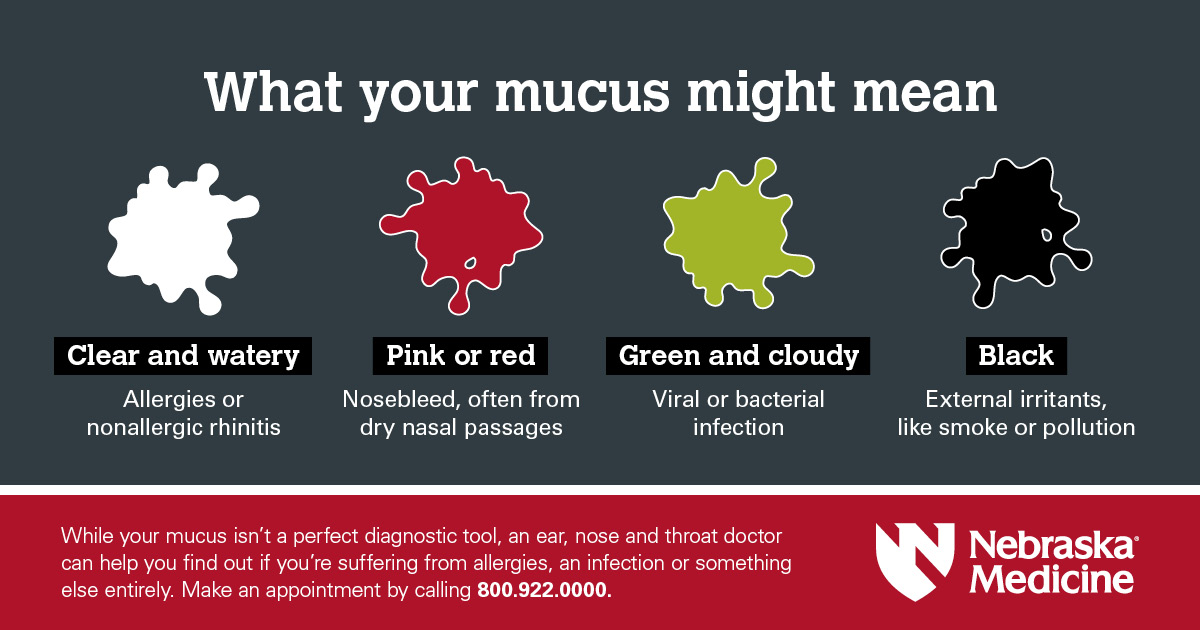Is it allergies, COVID-19 or something else? What your mucus might mean

"There's a lot of people suffering from sinus disease. Your sinus health is important to address, and impacts your well-being and quality of life. Don't wait to come in, because there are things we can do to help you."
These words of encouragement come from Christie Barnes, MD, an ear, nose and throat (ENT) doctor who treats people with sinus diseases. While Dr. Barnes says your sinus discharge is just one factor an ENT doctor uses to diagnose a condition, your mucus color and consistency might offer you some clues.
Spoiler alert: The best way to find out if you have COVID-19 is to get tested. With that public service announcement out of the way, here are what different types of mucus might indicate.
Clear and watery: allergies or nonallergic rhinitis
"Clear drainage tends to be associated with early onset of a cold, seasonal allergies or nonallergic rhinitis," says Dr. Barnes. "If it's allergies, that tends to be accompanied by itchiness, watery eyes and sneezing."
Nonallergic rhinitis is a drippy nose that could have several causes. "Nonallergic rhinitis could be related to your work exposure, like from irritants," says Dr. Barnes. Another cause of nonallergic rhinitis could be hormone shifts. "As we age, the hormone changes after menopause can affect the moisture of the nose," explains Dr. Barnes. The stereotype of a little old lady with a runny nose would fit into the category of nonallergic rhinitis.
But clear drippy drainage out of just one nostril could signal a serious condition called cerebrospinal fluid (CSF) rhinorrhea. "That raises the alarm for anyone who has experienced head trauma, for example after a car accident or skull fracture," says Dr. Barnes. If only one nostril is gushing watery discharge, seek medical attention right away.
Green and cloudy: viral or bacterial infection
"Cloudy, discolored drainage – like green or yellow – usually means a viral or bacterial infection," says Dr. Barnes. "If it's bacterial, you could see your doctor for an antibiotic or you might need to just give it some time. If it's a viral infection, antibiotics won't do you any good."
A lot of the symptoms of viral infections – fever, cough, headache, loss of smell – overlap for COVID-19 and other viral infections like the flu, RSV and the common cold. That's why COVID-19 testing and seeing your doctor is so important.
You can treat most infections with rest, hydration and symptom control. See how critical care physician and pulmonologist Brian Boer, MD, advises how to fight COVID-19 at home.
Whether it's COVID-19 or another contagious illness, please stay home if you're sick. Don't go out in public or work. Ask someone healthy to get you groceries or medicine, or use at-home delivery.
Pink or red: nosebleed, often from dry nasal passages
Sometimes after (or during) an infection, your nasal discharge can turn pink, especially if you've been blowing your nose a lot. Usually, this isn't a big concern – a saline spray or a humidifier may help.
"If you're getting frequent nosebleeds, you can see your doctor about that," says Dr. Barnes.
Black: external irritants, like smoke or pollution
Black drainage is pretty uncommon, but it can happen. "I've had patients who had dark drainage after spending a lot of time outside when there were a lot of fires," recalls Dr. Barnes. "Also, if you live in or travel to a city with a lot of pollution, you might also experience discolored, brown drainage."







